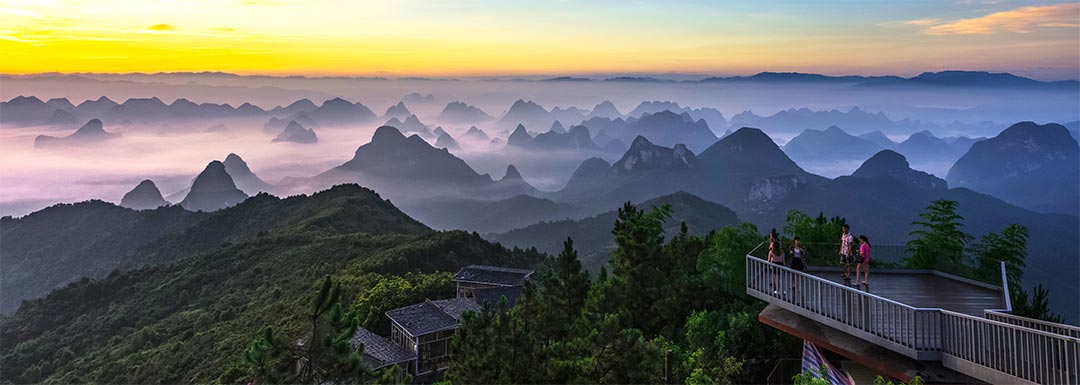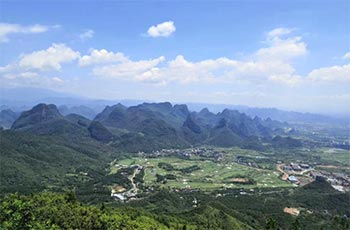The Yao Mountain

The Yao mountain is the highest mountain in Guilin. It is named after a temple on the mountain built for Emperor Yao in the Zhou-Tang Dynasty. The Longevity-Buddha Temple and the White-cloud Taoist Temple are all built on the former site of the Yao Temple. Before the temple lies a piece of rice field called “Heaven-given Field”, as it guarantees stable yields despite drought or excessive rain. At altitudes of 600-700 meters, there is the White-deer Temple. It used to be the residing place of a Tang dynasty Zen master, called White-deer Master. It is also called the Pavilion of the Jade Emperor. Around an altitude of 200 meters, there is the Holy-wishes Nunnery, also called Maoping Nunnery, built in the Ming dynasty. At the foot of the Yao mountain lies the mausoleum of the Ming dynasty’s Jingjiang Prince. The mausoleum comprises more than 300 tombs. On the Yao mountain there are two-way cable cars and a slide-way going downhill. Climbing to the top of the Yao mountain, and you will have a panoramic view of the landscapes of Guilin.
- Chinese name: 尧山 Yáo Shān
- Duration: 3-5 hours
- Entrance Fee: RMB 95 (with two-way cable car included)
- Opening hours: 9:00 am - 4:00 pm
- Best time to visit: April to October
- How to get there: Take Bus No.2, Bus No.203 or Bus No.206 to Fubo Hill.
- Address: Eastern Suburb, Diecai District, Guilin City, Guangxi Zhuang Autonomous Region
- How to get there:
Take Bus No. 302 at the No.6 Petroleum Co. Station, then change to Bus No. 24
Take K2 at Sanlidian Squre North Station, then change to Bus No. 24
Take Bus No. 306 at Sanlidian Squre Station, then change to Bus No. 24
Take Bus No. 16 at Sanlidian Squre West Station, then change to Bus No. 24
Take Bus No. 32/302/32 (partial) at the No.6 Petroleum Co. Station, then change to Bus No. 24 (partial)
(take Bus No. 24 and get off at Jingjiang Prince’s Mausoleum Station. After touring the mausoleum, walk for 5 minutes as the road signs direct, then you can reach the Yao Mountain)
Taxi: Costs around RMB 30 from the city center to the Yao Mountain
Highlights of Yaoshan
1. Heaven-given Field and Heaven-given Spring
Half way up the Yao mountain lie several acres of rice fields. According to legends, they are granted by Emperor Yao and they are harvested every year, thus called the “Heaven-given Fields”. Water in the fields comes from the Jade-breast Spring and it never runs out all year around. Generations of monks living in the Longevity-Buddha Temple have devoted their lives to cultivating the rice fields as a way to support the daily operations of the temple. The temple enjoyed its heyday in the Qing dynasty, when as a sacred site it was visited by devout believers all year around.
The Heaven-given Spring is in a ravine half way up the Yao mountain, about a hundred meters away from the Yao Mountain TV Tower. A stone carved with “Heaven-given Spring” stands beside the Yaoshan Road. The spring comes up in a stone cavern on the mountain. The spring water is clear and sweet and never runs out all year round. Use the Heaven-given water to brew the Yao mountain tea leaves, and the air will instantly become heavy with the aroma of the tea.
 The Karst Landscape view from the top of the mountain
The Karst Landscape view from the top of the mountain 2. Karst Landscapes
Guilin city is situated at the south-western part of the Nanling ridges. With the average altitude being 150 meters, Guilin displays a typical Karst topography. The limestone that covers the surface of this city, after eons of weathering and erosion, has formed this unique scenery of numerous steep peaks, amazing karst caves, and beautiful stalactites. Climb to the top of the Yao mountain, and you will have a panoramic view of the magnificent Karst landscapes of Guilin.
3. Azalea
In March, in the late spring, the Yao mountain turns into a sea of Azaleas. There are an amazing variety of azaleas on the Yao mountain, and all of them have bright colors, such as purple, green, red, orange, and pink. The renowned Chinese poet Liu Yazi once wrote poems in praise of the azaleas on the Yao mountain. The scenery here is absolutely wonderful.
Drop us a line and we'll connect you with the top China expert in no time!